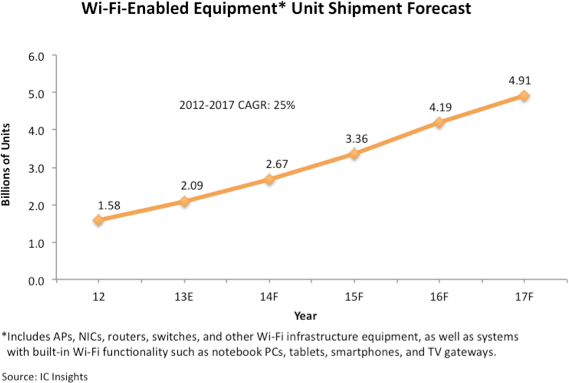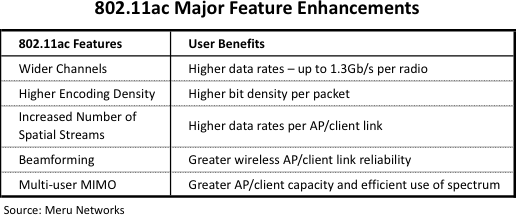Wireless networking still driving IC market
IC Insights have today announced that the 2014 edition of IC Market Drivers report will be released in November. Now a standard capability in many electronic systems (e.g., laptop and desktop PCs, tablets, smartphones, residential gateways, etc.), wireless networking is one of the key topics included in the new report.
Built-in wireless networking capability can be found in many electronic products such as printers, digital cameras, portable media players, e-book readers, video game consoles, speakers and entertainment systems, and televisions. High-end automobiles have included wireless networking for several years, but that feature continues to migrate down into the mainstream vehicle realm.
With the growing movement to conserve and monitor energy consumption, smart appliances with wireless networking capabilities are emerging. In addition, cellular service providers are increasing their use of wireless networks to offload data traffic from their strained cellular networks. The application space for wireless network technologies is vast and continues to expand.
As an example, a unit shipment forecast for Wi-Fi (802.11)-enabled systems and products is provided in Figure 1. From a unit perspective, the Wi-Fi industry blew through the 2008-2009 recession as though it never existed. Demand for traditional Wi-Fi products (e.g., routers, switches, access points) slowed up some during the recession, but that drop in demand was made up more than enough by newer Wi-Fi applications such as smartphones and tablet computers.
Unit shipments of Wi-Fi-enabled equipment surged 54% in 2010, followed by 46% in 2011 and another 36% in 2012. For 2013, IC Insights estimates that Wi-Fi-enabled system growth climbed 32% to 2.1 billion units, another very good year for this market segment. From 2012 to 2017, the average annual growth rate for Wi-Fi products is forecast to be a strong 25%. Cumulative Wi-Fi-enabled equipment unit shipments are forecast to reach the 10 billion mark in 2014, six years after achieving one billion cumulative units. Note that the equipment in the unit counts includes APs, NICs, routers, switches, and other Wi-Fi infrastructure products, as well as systems with built-in Wi-Fi functionality such as laptop PCs, tablet computers, smartphones, broadband gateways, video game consoles, 3G/4G small cell devices, etc.

Figure 1
While 802.11n has been the most successful version of Wi-Fi yet, expectations for the next-generation standard—802.11ac—have been set even higher. The extraordinary growth in the number of mobile wireless devices and the data-intensive applications they run has created high demand for wireless connectivity with much greater bandwidth, speed, range, reliability, security, etc. In order to provide reliable, uninterrupted service for a growing amount of bandwidth-intensive applications such as HD video, an exploding quantity of Wi-Fi devices are being used, and for new Wi-Fi applications such as wireless displays and indoor positioning, the new 802.11ac wireless standard is emerging from development labs.
Even though the 802.11ac standard is not expected to be finalized until early 2014, IC manufacturers started shipping “pre-ac” devices in mid-2012 and system products (routers, access points, laptops, smartphones, etc.) started appearing on the market soon after. The Wi-Fi Alliance, which is the organization that certifies whether or not products comply with the 802.11 standards, has split the 802.11ac specification into two certification phases called Wave 1 and Wave 2. Unlike 802.11n, which is available in both the 2.4GHz and 5GHz bands, 802.11ac uses only the 5GHz band (the IEEE describes it as the <6GHz band). The new standard, which is sometimes called “5G Wi-Fi” because it is the fifth generation of Wi-Fi, incorporates many techniques that greatly increase both the data rate and wireless range.
Figure 2 lists the major features provided by 802.11ac as compared to prior 802.11 standards. While most discussions pertaining to .11ac focus on its speed, another important improvement is that the technology can be as much as 5x more energy-efficient than .11n because it can transfer a given amount of data in much less time, thereby saving on battery life.

Figure 2










